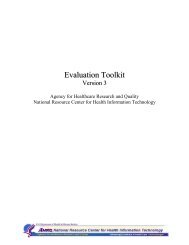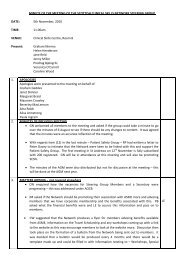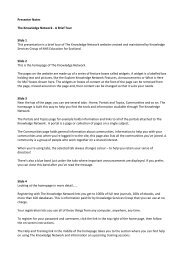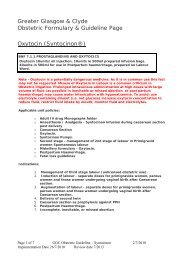The Fife Dementia Strategy: 2010 â 2020 - The Knowledge Network
The Fife Dementia Strategy: 2010 â 2020 - The Knowledge Network
The Fife Dementia Strategy: 2010 â 2020 - The Knowledge Network
You also want an ePaper? Increase the reach of your titles
YUMPU automatically turns print PDFs into web optimized ePapers that Google loves.
4.5 Housing<br />
AIM<br />
Support people with dementia to access housing options which meets<br />
their care and lifestyle needs including appropriate support to remain in<br />
the home of their choice.<br />
RECOMMENDATIONS TO ACHIEVE THIS<br />
4.5.1 <strong>The</strong> housing needs of older people and people with dementia are<br />
identified in the <strong>Fife</strong> Council Specific Needs Housing Approach, and are<br />
given appropriate housing choices in Housing Options discussions.<br />
<strong>The</strong> number of older people living in <strong>Fife</strong> is increasing at a dramatic rate, and<br />
with the shifting balance of care from institutional environments into the<br />
community, peoples’ homes are increasingly becoming the location for a<br />
range of support and care activities. It is thus important that houses are<br />
appropriately designed and equipped for the provision of care (for example<br />
bungalows without steps/stairs, bedrooms large enough for a bed to be<br />
turned, main floor bathroom facilities including showering, and wheelchair<br />
accessible doorways). This will present many challenges to the current<br />
housing situation as the care and support provided to older people if often<br />
linked to the accommodation lived in, rather than the needs of the individual.<br />
This is of concern, especially as the governments focus remains on providing<br />
affordable housing that is built to barrier-free standards. It is intended that<br />
such barrier-free housing will have the flexibility to be adapted to suit the<br />
needs of people with dementia; however resources and services for<br />
adaptation and other support for the specific needs of the aging population<br />
whose homes, new or old, may grow unsuitable as their physical and<br />
cognitive abilities change, are limited.<br />
Age brings with it a greater acknowledgement of interdependence with family,<br />
community, services, and neighbourhood. To achieve the right balance<br />
between these means looking at planning for new homes and<br />
neighbourhoods which can sustain the changes of a lifetime; providing<br />
impartial information at an earlier stage so that people can make better<br />
informed and more confident decisions about a greater choice of quality<br />
housing options; have access to increased support to enable people either to<br />
stay in their own homes; or to move on.<br />
To meet the challenges due to the aging population we must work across<br />
health, social care and housing services to plan for homes and communities<br />
that people can live out their lives in. People should be supported to remain<br />
independent, and feel safe in a community with their families and friends, and<br />
with accessible facilities around them for as long they wish to. We want to<br />
ensure that people are able to make the right choices at the right time with the<br />
right range of ‘specialist’ housing available for those who need more support<br />
including sheltered, very sheltered and extra care housing. Housing is central<br />
43
















